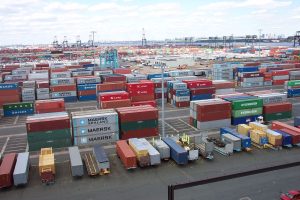In the intricate world of port logistics and shipping services, optimizing revenue recovery is crucial for maintaining a competitive edge and ensuring operational longevity. The complexity of managing vast networks of cargo, fleets, and international trade regulations demands strategic approaches to enhance efficiency, manage finances effectively, and leverage technological advancements. This article explores multifaceted strategies designed to optimize revenue recovery in the dynamic environment of port logistics and shipping services, addressing everything from port efficiency and financial management to data analytics, regulatory compliance, and building resilient supply chains.
Key Takeaways
- Advanced scheduling systems, automation, and infrastructure upgrades are pivotal for enhancing port efficiency and throughput.
- Financial health in port operations can be bolstered by employing cost reduction techniques, diversifying revenue streams, and investing in technology.
- Data analytics, including predictive analytics and real-time data, play a significant role in improving demand forecasting and asset utilization.
- Staying abreast of international shipping laws and implementing risk management strategies are essential for navigating regulatory compliance.
- Building resilient supply chains involves fostering partnerships, adapting operations to market volatility, and committing to sustainability.
Strategies for Enhancing Port Efficiency
Implementing Advanced Scheduling Systems
We’re revolutionizing the way ports operate by implementing advanced scheduling systems. These systems are the backbone of efficiency, ensuring that every vessel, truck, and cargo handling operation is timed to perfection.
- Minimize idle time
- Maximize resource utilization
- Enhance coordination among stakeholders
By synchronizing all moving parts, we’re not just optimizing operations; we’re optimizing revenue recovery.
Advanced scheduling goes beyond mere time management. It’s about predictive adjustments to operations, anticipating issues before they arise. This proactive approach is key to maintaining a competitive edge in the fast-paced world of port logistics and shipping services.
Adopting Automation and Robotics
We’re revolutionizing our port operations by embracing the power of automation and robotics. Efficiency is skyrocketing as we integrate these technologies, transforming the way we handle cargo. Our focus is on precision, speed, and reliability, ensuring a seamless flow from ship to shore.
Automation isn’t just about replacing manual labor; it’s about creating a smarter, more connected port environment. We’re seeing a significant reduction in human error and a boost in safety, which translates to better service for our clients.
- Streamlined container movement
- Enhanced tracking and sorting
- Reduced downtime and maintenance
By adopting these advanced systems, we’re not just keeping pace with industry trends; we’re setting new standards for operational excellence.
The integration of robotics has been a game-changer, particularly in areas that demand high precision or are hazardous for our workforce. We’re committed to ongoing investment in these areas to maintain our competitive edge.
Upgrading Infrastructure for Improved Throughput
We recognize the pivotal role of modern infrastructure in propelling port efficiency. Investing in state-of-the-art facilities is not just an upgrade, it’s a revolution in how we handle cargo. Enhanced docks, cranes, and storage solutions lead to a seamless flow of goods, slashing wait times and boosting productivity.
Throughput is the lifeblood of port operations. To ensure its steady pulse, we prioritize the following upgrades:
- Expansion of container storage areas
- Modernization of cargo handling equipment
- Implementation of automated gate systems
By streamlining operations, we not only recover revenue but set the stage for future growth. Our commitment to infrastructure is a commitment to excellence.
The dividends of these enhancements are clear: reduced bottlenecks, faster turnaround times, and a competitive edge in the global market. We’re not just keeping pace; we’re setting the pace.
Financial Management in Port Operations
Cost Reduction Techniques
In our quest to optimize revenue, we’ve honed in on cost reduction techniques that significantly impact our bottom line. Streamlining operations is at the heart of our strategy, eliminating waste and enhancing productivity.
- Negotiate better terms with suppliers
- Optimize energy consumption
- Reduce overhead through shared services
By meticulously analyzing every expense, we uncover opportunities for savings that might otherwise go unnoticed.
We’ve also embraced technology to automate processes, cutting down on manual labor and associated costs. The result? A leaner, more efficient operation that’s primed for profitability.
Diversifying Revenue Streams
In our quest to optimize revenue recovery, we recognize the power of diversifying revenue streams. It’s not just about increasing the number of income sources; it’s about creating a robust financial ecosystem that can withstand market fluctuations.
- Exploring new markets
- Developing ancillary services
- Capitalizing on digital platforms
By tapping into alternative markets and services, we’re not putting all our eggs in one basket. This strategic move ensures a steady cash flow from multiple channels, cushioning the impact of any single market downturn.
Diversification is our buffer against uncertainty, allowing us to navigate the unpredictable tides of global trade with confidence.
Investing in Technology for Long-Term Savings
We understand that the logistics and transportation industry relies heavily on technology to streamline operations. The initial investment may be substantial, but the long-term savings are undeniable. By embracing innovative solutions, we position ourselves for enduring success.
- Upfront costs are offset by long-term efficiency gains.
- Technology drives agility and adaptability in our operations.
- Compliance with regulations is simplified through tech upgrades.
Investing in technology is not just about keeping up; it’s about staying ahead. We ensure our place at the forefront of the industry by prioritizing tech-driven strategies.
The path to financial sustainability in port logistics involves a careful balance between immediate expenses and future benefits. We’re committed to navigating this with foresight and precision.
Leveraging Data Analytics for Revenue Recovery
Utilizing Predictive Analytics for Demand Forecasting
We harness the power of predictive analytics to stay ahead of the curve in demand forecasting. By analyzing historical data and current market trends, we can anticipate customer needs and adjust our strategies accordingly. This proactive approach ensures optimal inventory levels and reduces waste, leading to a more streamlined operation.
Predictive analytics also plays a crucial role in risk management. By identifying potential issues before they arise, we can implement preventative measures to safeguard our revenue streams. DCI’s integration of innovative software and data analytics is a testament to the effectiveness of this strategy.
Our commitment to leveraging cutting-edge technology is unwavering. We understand that the ability to predict and adapt to market demands is not just a competitive advantage but a necessity in today’s fast-paced business environment.
- Anticipate customer needs
- Adjust inventory management
- Implement preventative measures
- Safeguard revenue streams
Improving Asset Utilization with Real-Time Data
We harness the power of real-time data to transform our asset utilization. Bold decisions are backed by instant insights, allowing us to pivot operations swiftly and efficiently. This agility is crucial in the fast-paced world of port logistics and shipping services.
- Real-time tracking of cargo and equipment
- Dynamic allocation of resources based on current demand
- Predictive maintenance schedules to prevent downtime
By integrating real-time analytics, we’re not just reacting to the market; we’re anticipating it. This proactive approach ensures that every asset is leveraged to its fullest potential, maximizing revenue recovery.
Real-time analytics and automated payment systems drive proactive debt recovery and cash flow management, reducing default rates and enhancing customer relationships through technology-driven strategies.
Enhancing Decision-Making with Business Intelligence Tools
We harness the power of Business Intelligence (BI) tools to transform raw data into actionable insights. These insights empower us to make informed decisions swiftly, staying ahead in the competitive port logistics landscape. Our strategic choices are now data-driven, ensuring we address the real needs of the market and our operations.
- Identify key performance indicators (KPIs)
- Monitor operational metrics in real-time
- Adjust strategies based on trend analyses
By integrating BI tools, we’ve streamlined our decision-making process, cutting through the noise to focus on what truly matters.
We’ve seen firsthand how BI tools reduce inefficiencies and enhance performance. For instance, businesses can leverage data analytics to reduce returns by analyzing customer behavior and purchase patterns to optimize offerings and improve targeting, ultimately reducing return likelihood.
Navigating Regulatory Compliance and Risk Management
Understanding International Shipping Laws
We navigate the complex seas of international shipping laws to safeguard our operations. Compliance is non-negotiable; it’s the anchor that keeps us steady amidst the legal storms. By mastering the regulations, we turn potential obstacles into streamlined processes.
Global logistics face a myriad of financial risks, including market volatility, credit risk, and regulatory compliance costs. Our strategy is threefold: proactive crisis management, deep compliance knowledge, and seamless technology integration for risk mitigation.
We’re committed to transforming regulatory challenges into competitive advantages.
To stay ahead, we continuously monitor and adapt to the ever-changing legal landscape:
- Keeping abreast of international trade agreements
- Understanding the nuances of maritime law
- Ensuring our documentation is bulletproof
Each step is a critical link in the chain of our overall risk management strategy.
Mitigating Risks with Comprehensive Insurance Policies
In our quest to safeguard our operations, we’ve embraced comprehensive insurance policies as our bulwark against the unforeseen. We mitigate risks by integrating robust coverage that spans the breadth of our activities, from cargo damage to liability concerns.
Insurance isn’t just about compliance; it’s a strategic asset. We leverage it to ensure financial stability and service continuity, even when the seas of commerce are stormy. Our approach is twofold:
- Assessing potential risks with precision
- Tailoring insurance solutions to fit our unique needs
By preemptively addressing vulnerabilities, we position ourselves to navigate through disruptions with confidence.
Our commitment extends beyond mere risk aversion. We actively engage with insurance providers to stay ahead of the curve, incorporating the latest in risk mitigation and technology. This proactive stance fortifies our financial resilience, allowing us to focus on what we do best: delivering exceptional port logistics and shipping services.
Ensuring Compliance through Regular Audits and Training
We recognize the importance of steadfast adherence to regulations. Regular audits are our compass, guiding us through the complex seas of international trade. They are not mere formalities but the backbone of our compliance strategy.
Training is equally critical. It empowers our crew with the knowledge to navigate legal waters confidently. We ensure that every team member is up-to-date with the latest regulatory changes and best practices.
Effective communication is the lynchpin that holds our compliance framework together. It ensures that everyone is on the same page, from the deck to the dock:
- Clear dissemination of compliance policies
- Open channels for feedback and queries
- Regular updates on legal and procedural changes
We sail together, ensuring that our operations not only meet but exceed the standards set before us. Our commitment to compliance is unwavering, as it anchors our financial stability and mitigates risk.
Building Resilient Supply Chains
Fostering Collaborative Partnerships
In our quest to build resilient supply chains, we recognize the power of fostering collaborative partnerships. By uniting with strategic allies, we leverage collective strengths, ensuring a more robust and responsive logistics network.
Communication and collaboration are the bedrocks of these relationships. We prioritize transparency and shared goals, which are essential for mutual success. This approach not only strengthens our bonds but also streamlines operations, leading to enhanced efficiency and profitability.
Financial tools are crucial in maintaining cash flow and mitigating risks. They provide the stability needed to navigate the unpredictable waters of international shipping.
We address common challenges head-on, crafting solutions that benefit all parties involved. Our commitment to collaboration is unwavering, as it is a cornerstone of our strategy to thrive in the dynamic world of port logistics and shipping services.
Adapting to Market Volatility with Agile Operations
In the face of unrelenting market volatility, we’ve learned that agility is not just a buzzword—it’s our lifeline. We pivot swiftly, adapting our operations to meet the shifting demands of global trade. Our strategy hinges on a proactive stance, anticipating change rather than reacting to it.
Flexibility in our supply chain is critical. We streamline processes and maintain a lean inventory, ensuring we can scale up or down with ease. This approach minimizes waste and maximizes responsiveness.
- Assess current operational flexibility
- Identify areas for improvement
- Implement agile methodologies
- Regularly review and adjust strategies
By embedding agility into our operations, we safeguard against the unpredictable, turning potential disruptions into opportunities for growth.
The long-term financial impact of disruptions in the logistics and transportation industry cannot be overstated. Our commitment to adaptability, agility, and technological innovations is the bedrock of our stability and resilience.
Investing in Sustainability for Future-Proofing
We’re at the forefront of integrating sustainability into our core strategies. Our commitment to eco-friendly operations is not just about compliance; it’s about setting new industry standards. By focusing on sustainable logistics practices, we’re mitigating logistics debt and preparing for a future where climate resilience is non-negotiable.
We recognize that our actions today shape the maritime landscape of tomorrow. Investing in green technologies and processes is an investment in our collective future.
To ensure we’re on the right track, we’ve identified key areas of focus:
- Developing climate-resilient infrastructure
- Embracing renewable energy sources
- Enhancing waste reduction and recycling efforts
These initiatives are not just environmentally responsible; they’re economically savvy. Collaboration and innovation drive our approach, leveraging technology for resilience and efficiency in our operations.
In today’s volatile market, the ability to maintain a resilient supply chain is more crucial than ever. At Debt Collectors International, we specialize in safeguarding your financial interests by recovering owed balances efficiently and effectively. Our seasoned experts are well-versed in dispute resolution, skip tracing, and judgment enforcement, ensuring that your supply chain remains robust against any financial disruptions. Don’t let outstanding debts undermine your business’s stability. Visit our website to learn more about our comprehensive debt collection solutions and take the first step towards fortifying your supply chain.
Frequently Asked Questions
How can advanced scheduling systems enhance port efficiency?
Advanced scheduling systems can optimize the allocation of resources, reduce waiting times for ships, and streamline the loading and unloading processes, ultimately increasing the throughput and efficiency of port operations.
What role does automation play in improving port logistics?
Automation and robotics can significantly improve port logistics by handling repetitive tasks, reducing human error, increasing safety, and enabling operations to continue around the clock, thus enhancing overall productivity.
In what ways can upgrading port infrastructure contribute to revenue recovery?
Upgrading port infrastructure, such as deepening channels, improving terminal facilities, and expanding storage capacity, can accommodate larger vessels, reduce congestion, and speed up operations, leading to increased revenue through higher turnover.
How does diversifying revenue streams help in financial management of port operations?
Diversifying revenue streams, such as by offering value-added services, leasing port facilities, or developing commercial real estate, can provide ports with more stable income sources and reduce dependency on traditional cargo handling fees.
What is the importance of predictive analytics in port logistics?
Predictive analytics can forecast demand, optimize resource allocation, and anticipate potential disruptions, allowing ports to make informed decisions, reduce operational costs, and improve customer service.
Why is it essential for ports to invest in sustainability?
Investing in sustainability, such as by adopting clean energy sources and implementing eco-friendly practices, can reduce environmental impact, comply with regulations, and attract eco-conscious clients, ensuring the port’s long-term viability and competitiveness.





